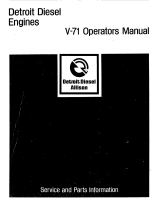
Table of Contents
1 Safety
1.1 General conditions 5
1.2 Personnel and organizational requirements 6
1.3 Transport 7
1.4 Crankshaft transport locking device 8
1.5 Explosion hazard when removing
inspection port cover on engine 11
1.6 Safety regulations for maintenance and
repair work 12
1.7 Auxiliary materials, fluids and lubricants,
fire prevention and environmental
protection 15
1.8 Conventions for safety instructions in the
text 17
2 Product Summary
2.1 Engine Layout 18
2.2 Overview of sensors, actuators and
injectors 19
2.3 Engine – Main dimensions 23
2.4 Firing order 24
2.5 Final compression pressure 25
2.6 Engine side and cylinder designations 26
2.7 20V 4000 Gx3 engine data: Continuous
operation, variable 3B, optimized fuel
consumption 27
2.8 20V 4000 Gx3 engine data: Continuous
operation, variable 3B, optimized exhaust
emissions ("TA-Luft") 32
2.9 20 V 4000 Gx3 engine data: Standby
operation 3D, optimized fuel consumption,
6ETC 35
3 Operation
3.1 Putting the engine into operation after
extended out-of-service periods (>3
months) 40
3.2 Putting the engine into operation after
scheduled out-of-service-period 41
3.3 Start engine in manual mode (testing
mode) 42
3.4 Safety system – Override 43
3.5 Operational checks 44
3.6 Starting the engine in emergency situations
(override mode) 45
3.7 Stop engine in manual mode (testing
mode) 46
3.8 Emergency stop 47
3.9 After stopping the engine – Engine remains
ready for operation 48
3.10 After stopping the engine – putting the
engine out of service 49
3.11 Plant cleaning 50
4 Maintenance
4.1 Maintenance task reference table [QL1] 51
5 Troubleshooting
5.1 Troubleshooting 52
5.2 Engine governor ADEC (ECU 7) for Series
4000 genset engines – Fault messages 55
6 Task Description
6.1 Engine 104
6.1.1 Engine – Barring manually 104
6.1.2 Engine – Barring with starting system 105
6.1.3 Engine – Test run 106
6.2 Cylinder Liner 107
6.2.1 Cylinder liner – Endoscopic examination 107
6.2.2 Cylinder liner – Instructions and comments on
endoscopic and visual examination 109
6.3 Crankcase Breather 111
6.3.1 Crankcase breather – Oil mist fine separator
replacement 111
6.4 Valve Drive 112
6.4.1 Valve gear – Lubrication 112
6.4.2 Valve clearance – Check and adjustment 113
6.4.3 Cylinder head cover – Removal and
installation 117
6.5 Injection Pump / HP Pump 118
6.5.1 HP pump – Filling with engine oil 118
6.6 Injection Valve / Injector 119
6.6.1 Injector – Replacement 119
6.6.2 Injector – Removal and installation 120
6.7 Fuel System 125
6.7.1 Fuel system – Venting 125
MS150093/01E 2012-06 | Table of Contents | 3
DCL-ID: 0000005896 - 002






















